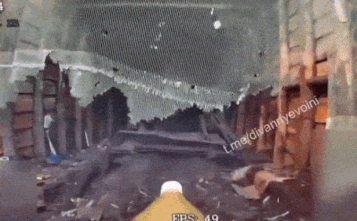Ukraine's Drone Force Is Blowing Up the Industrial Infrastructure Supporting Russia's Best Unjammable Drones
A Russian fiber-optics factory just went up in flames
On the night of April 4, a dozen Ukrainian attack drones motored 460 miles into Russia and struck a factory in the city of Saransk.
And not just any factory. The target was the Optic Fiber Systems factory, which produces—you guessed it—fiber-optic cables: the critical component in Russia’s best unjammable first-person-view drones.
The strike, which left the facility in flames, is part of Ukraine’s ongoing effort to get “left of the boom,” to borrow U.S. Army slang—and strike Russia’s fast-improving drone enterprise where it’s most vulnerable. At the industrial level.
Russian bloggers were aghast. “Of course, the Ministry of Defense and the military-industrial complex couldn’t possibly protect the only optical fiber plant in Russia!” one blogger moaned in a missive translated by the Estonian analyst WarTranslated. “Why bother? We’ll just buy it from China.”
The Friday raid was the latest in series of attacks targeting the Russian drone industry. On March 13, long-range drones belonging to the Ukrainian defense intelligence agency struck a hidden drone manufacturing facility in Obukhovo, just outside Moscow 300 miles from the border with Ukraine.
And in April, Ukraine sortied one of its then-new Aeroprakt A-22 sport plane drones to strike a drone plant in Yelabuga, 550 miles east of Moscow.
Left of boom
The latest raid may be the first specifically targeting the infrastructure for fiber-optic drones, which send and receive signals via millimeters-thick—but miles-long—fibers instead of via radio, which is highly susceptible to Ukrainian electronic warfare.
Small, maneuverable and impossible to jam, fiber-optic drones can—in the hands of skilled operators—slip into the buildings where soldiers are sleeping and dugouts sheltering valuable vehicles. The spider-web of used optical fiber blanketing the front line is testimony to the rapid proliferation of the radio-free drones, which have evolved through several increasingly efficient generations in just the last few months.
Desperate to blunt the Ukrainians’ drone advantage, the Russians leaned into fiber-optic technology starting last year and, in early January, turned the tables on the Ukrainians.
On Jan. 5, a company of Ukrainian paratroopers attacked the village of Berdin in western Russia’s Kursk Oblast. The Russian garrison met them with a swarm of fiber-optic drones—and defeated the attack, sowing the snowy fields around Berdin with the mangled bodies of dead paratroopers.
While rushing to develop its own efficient fiber-optic drones, the Ukrainian Unmanned Systems Forces—the world’s first independent drone branch—also scrambled to develop countermeasures to Russia’s fiber-optic FPVs. Initially, the Ukrainians resorted to spotting the unspooling fibers from the air and following them back to their operators—and then bombing them.
But this visual tracking method depends on luck and favorable light, and isn’t really scalable the way electronic warfare is—and the way deep strikes on factories are.
To prevent roadside bomb ambushes in Iraq and Afghanistan, U.S. forces learned to get ahead of the problem and hunt down the men who built and distributed the bombs. They aimed to get “left” of an attack on a left-to-right timeline.
Fifteen years later, Ukrainian forces are doing the same to prevent unjammable drone attacks—and leveraging precise intelligence to do so. The Ukrainians “are clever bastards,” the Russian blogger complained. “They know exactly where to hit.”
Read more:
Attacking Along a Main Road in Broad Daylight, a Large Russian Assault Group Broke a Lot of Rules—And Paid For It
A Russian assault group that attacked Ukrainian positions west of Andriivka in eastern Ukraine on or before Thursday broke a lot of rules.







